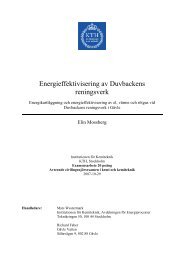Problematik vid höga flöden - Gästrike Vatten AB
Problematik vid höga flöden - Gästrike Vatten AB
Problematik vid höga flöden - Gästrike Vatten AB
Create successful ePaper yourself
Turn your PDF publications into a flip-book with our unique Google optimized e-Paper software.
the hopper of the primary sedimentation tanks to the inlet of the tanks, and allowing it to mix<br />
with the influent wastewater. In this way, VFA produced in primary sludge is washed out and<br />
fed to the anaerobic reactor (method modified from Tykesson et al., 2005). Additional<br />
diffuser blocks were also installed in the last quarter of the anaerobic tank to allow for a<br />
reduction of the anaerobic retention time during low-flow conditions. The EBPR process has<br />
since then been stable during normal operating conditions, and reducing the phosphorus<br />
content to an extent of approximately 95 % without any use of chemical precipitation.<br />
However, after long periods with high-flow conditions and low organic loadings in the order<br />
of weeks, the process has been deteriorating leading to increased effluent phosphorus<br />
concentrations and a need for chemical precipitation. Moreover, from the year 2012 the<br />
effluent requirements will become more stringent with an effluent discharge limit of 0.3 mg<br />
P/l instead of the present 0.4 mg P/l. To meet these new demands, and at the same time<br />
minimize the use of chemical precipitation, the problems with insufficient phosphorus<br />
removal at prolonged high-flow conditions must be solved.<br />
Several studies of the EBPR process during high-flow starving conditions have been<br />
conducted at a laboratory scale. However, there is a lack of knowledge from full scaleperformances<br />
at these conditions. The purpose of this paper has been to translate the<br />
knowledge from laboratory investigations in the literature, to a complex full-scale practice. A<br />
study of the full scale treatment plant Duvbacken has been made to identify critical keyfactors<br />
for the current process during prolonged high-flow conditions. The result from this<br />
study was then used to develop different operating control strategies and to implement them<br />
in full scale, with the purpose of preventing process failure and the need for chemical<br />
precipitation during and after high-flow events.<br />
METHOD<br />
The WWTP treats the wastewater for about 88,000 population equivalents (p.e.) and consist<br />
of a simple AO-configuration (anaerobic-aerobic) with a highly loaded activated sludge<br />
treatment system without nitrification. The flow scheme of the plant is plotted in figure 1.<br />
Influent<br />
pretreated<br />
wastewater<br />
Returned<br />
primary<br />
sludge<br />
By-pass<br />
Sedimentation tanks<br />
with primary sludge<br />
hydrolysis<br />
Return flow<br />
Excess primary sludge to<br />
sludge treatment<br />
Additional diffusers<br />
for low-flow<br />
conditions<br />
AN A1 A2<br />
Figure 1. Flow scheme of the WWTP. AN=anaerobic reactor, A1=aerobic reactor 1, A2=aerobic reactor 2, A3=aerobic<br />
reactor 3.<br />
55<br />
A3<br />
Return of activated sludge<br />
Flow-equalization tanks<br />
Settling tanks<br />
Sludge<br />
tank<br />
Excess sludge to<br />
sludge treatment<br />
Effluent during prolonged<br />
high-flow conditions<br />
(chemically treated)<br />
Effluent






